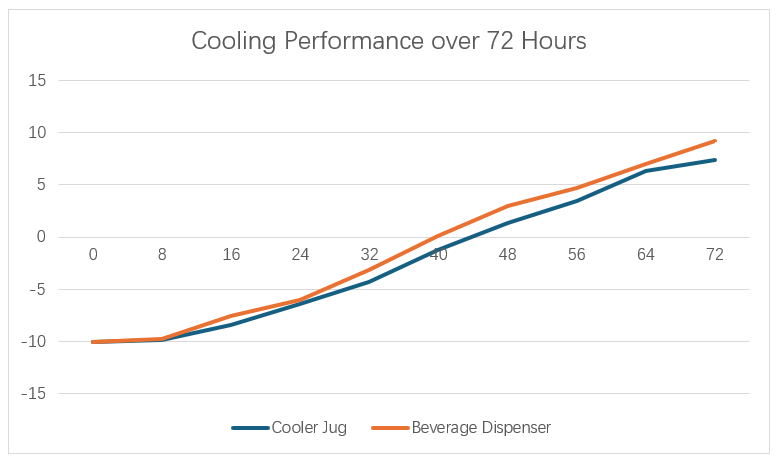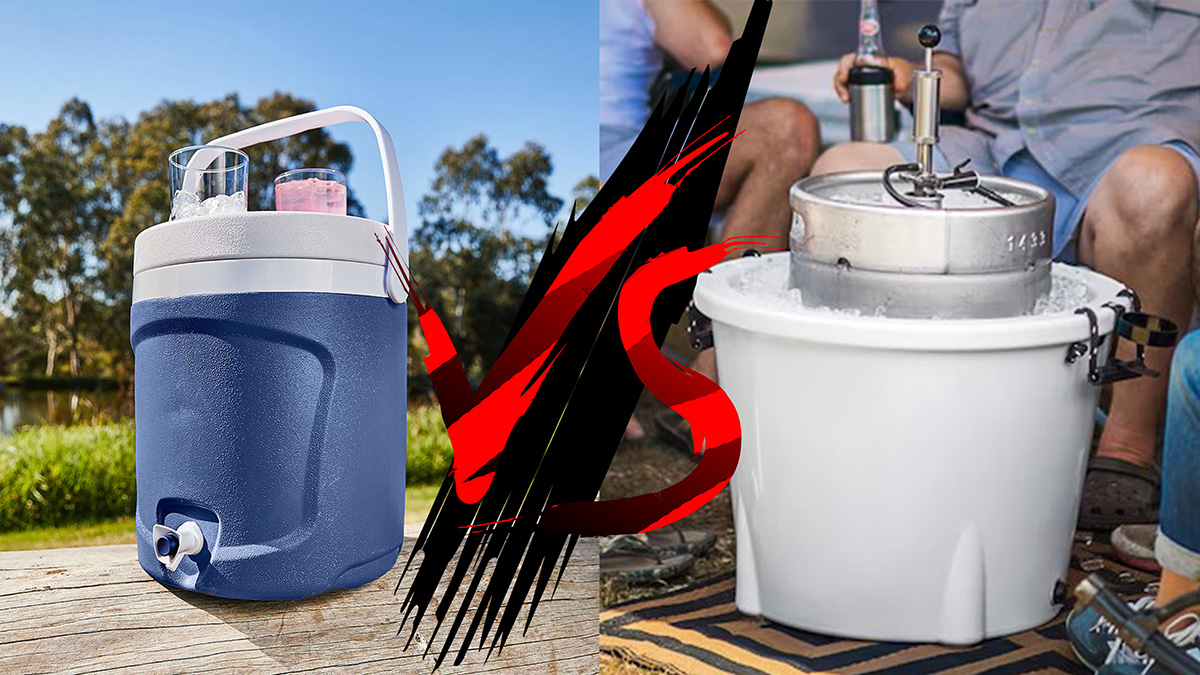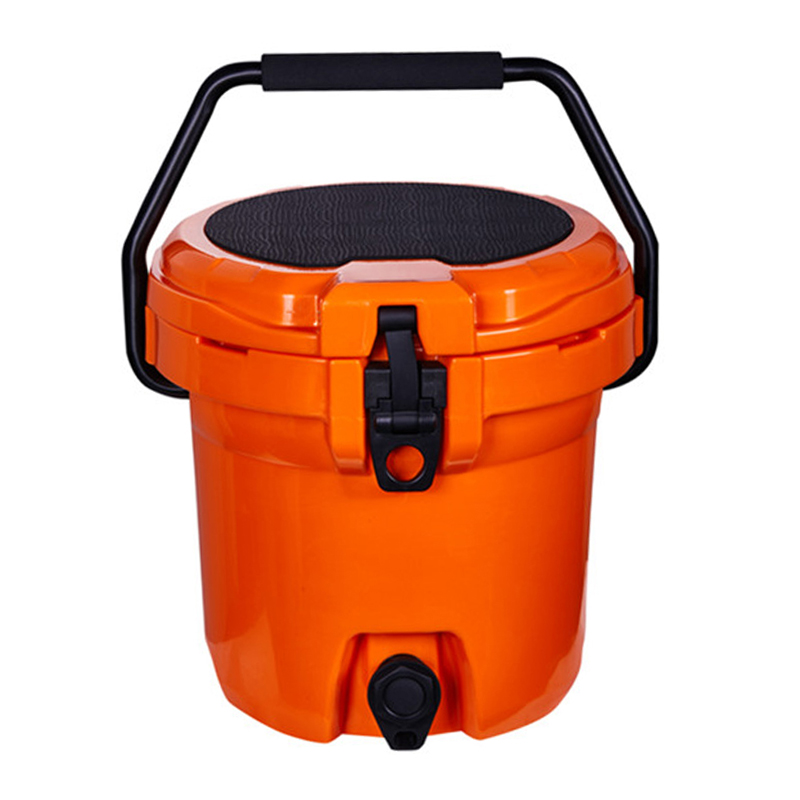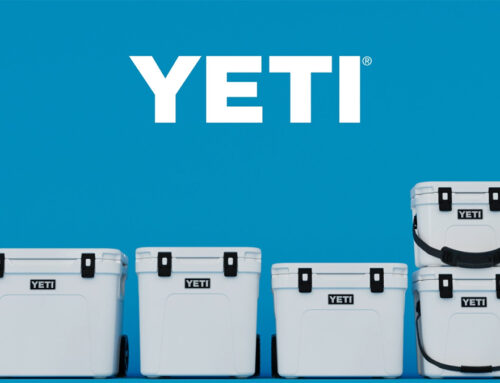When planning an outdoor adventure or hosting a backyard gathering, keeping drinks cold and easy to serve is essential. Among all other options, the most popular options are insulated water jugs and beverage dispensers — but they serve very different purposes.
So which one should we choose? Let’s break it down by features, applicable scenarios, insulation performance, and daily cleaning and maintenance.
1. What Is an Insulated Water Cooler Jug?
Before we dive into the comparison, let’s first look at what an insulated water cooler jug actually is.
Before we dive into the comparison, let’s first look at what an insulated water cooler jug actually is. An insulated water jug that we refer to here is a compact, portable container designed to keep liquids cold (or hot) for a long period. It typically does not have a spout or tap to give easy access to content, but is built for mobility and durability.
- Best For: Hiking, sports, beach days, or any activity where you’re on the move
- Key Features: Double-wall insulation, secure lid, easy to carry
- Main Advantage: Keeps beverages cold for hours without leaking or spilling
2. What Is a Beverage Dispenser?
Unlike the insulated water cooler jug, the beverage dispenser is designed with convenience in mind, especially when you’re serving drinks to a crowd.
- The Convenience of a Spout
One of the key features of a beverage dispenser is the built-in spout. This makes serving drinks much easier, especially during parties or large gatherings. Guests can help themselves, and there’s no need for constant pouring. - Perfect for Events and Gatherings
If you’re planning a BBQ, picnic, or family reunion, a beverage dispenser is the perfect choice. With its larger capacity and easy-to-use spout, it’s designed for efficient service at events with lots of guests.
In order to gather a clearer idea of both, you may wonder: how do these two options stack up against each other?
3. Key Differences: Portability vs. Convenience
The decision between an insulated water cooler jug and a beverage dispenser often comes down to how and where you plan to use them. Let’s look at the key differences in more detail.
- Portability of Insulated Water Cooler Jugs
One of the main advantages of an insulated water cooler jug is its portability. Since these jugs are designed to be easily transported from one place to another, if you need a container for a hike or camping trip, the cooler jug will keep your drinks cool for hours without the added bulk of a dispenser. - Convenience of Beverage Dispensers
On the flip side, the beverage dispenser is all about convenience. If you’re hosting a large gathering and want easy self-service, the spout and easy-pour design make it an excellent choice. It allows for faster service and less hassle.
Here’s a quick side-by-side comparison:
| Feature | Insulated Water Jug | Beverage Dispenser |
| Spout | No | Yes |
| Portability | High | Low to Medium |
| Best Use | Outdoor adventures | Parties & gatherings |
| Insulation | Strong (72+ hours) | Moderate to Strong (depends on model) |
| Serving Style | Manual pour or cup dip | Hands-free, self-serve tap |
| Cleaning | Easy | Requires disassembling tap |
| Cost | Lower | Slightly higher with features |
Now, let’s consider what types of drinks each is best suited for.
4. What Drinks Are Best for Each?
Choosing the right container depends on what you’re serving. Let’s explore the best use cases for each.
- Best for Hydration: Insulated Water Cooler Jug
When it comes to plain water, sports drinks, or other simple hydration needs, the insulated water cooler jug is your best bet. Its design ensures that your drinks stay cool, and it’s perfect for quenching your thirst during a hike or a long day in the sun. - Best for Mixed Drinks: Beverage Dispenser
If you’re serving iced tea, lemonade, or a fun punch, a beverage dispenser is the way to go. The spout allows for easy serving of drinks that are mixed and ready to go, and you don’t have to worry about opening and closing the container every time you want a refill.
Let’s take a closer look now at the impact insulation has on these containers.
5. How Does Insulation Affect Performance?
Both insulated water cooler jugs and beverage dispensers use thermal insulation to preserve cold temperatures, but the materials and effectiveness can differ. However, it’s important to note that insulation itself is not the key differentiator — both container types often utilize premium insulation technologies.
- High-Quality Insulating Materials
Many insulated water jugs, including those made by KingStar Mold, use thick foam-core polyurethane or polyethylene insulation. This material can maintain internal temperatures as low as 4°C (39°F) for over 24-72 hours, depending on external conditions. According to research from the U.S. Department of Energy, closed-cell foam insulation has one of the lowest thermal conductivity ratings, typically around 0.02–0.03 W/m·K, making it highly efficient for portable coolers and jugs.
Similarly, beverage dispensers also integrate insulation, though some models focus more on convenience than extended thermal performance. Double-wall designs with vacuum insulation or ice core inserts are common. For example, dispensers with ice chambers can hold beverages under 10°C (50°F) for 72+ hours, based on field testing
and user reviews from insulated beverage container manufacturers.

* The starting temperature is both -10 degrees Celsius, and the temperature is measured every 8 hours.
- Performance in Real-World Use
As shown in the cooling performance chart above, a tightly sealed insulated jug can limit temperature rise to just 7.4°C over 72 hours. In comparison, an unsealed beverage dispenser might experience a temperature increase to 9.2℃ in the same period. This demonstrates the impact of seal quality and insulation thickness, not just the product category.
In terms of thermal efficiency, both products can perform well if built with high-grade materials. For users concerned primarily with extended cold retention — such as outdoor workers, campers, or athletes — an insulated jug with full sealing offers superior performance. However, for social gatherings and events where access and convenience are priorities, a well-designed beverage dispenser with internal ice support can still keep drinks refreshingly cool for hours.
Sources related to material performance:
- S. Department of Energy – Insulation Materials Performance Data
- Consumer Reports – Cooler & Beverage Dispenser Insulation Tests
- Manufacturer testing data from KingStar Mold (internal test results, 2025)
Having talked about the professional aspects, let’s now move on to a practical point – after all, no matter how good the insulation is, we still have to clean it up after use, right?
6. Which Is Easier to Clean?
After all, nobody wants to spend a lot of their time cleaning after an event. So, how do these containers compare in terms of cleaning?
- Cleaning Insulated Water Cooler Jugs
Cleaning an insulated water cooler jug is typically quite easy. With a simple design and no spouts to worry about, you can quickly rinse or wipe it out after use (just like a regular water jar). This makes it a great option for people who need a low-maintenance or cleaning solution. - Cleaning Beverage Dispensers
Beverage dispensers, on the other hand, require a bit more effort. Cleaning the spout and ensuring no residue remains can take time, especially if sticky liquids or syrupy drinks were served. Make sure to clean every part thoroughly to avoid any build-up. Moreover, because it has a spout, compared to a water jug, it has more edges and corners. Therefore, if it is not cleaned thoroughly, it is very likely to breed bacteria.
As we move forward, let’s talk about cost — it’s often a deciding factor in the final choice.
7. Which Is More Cost-Effective?
When you’re on a budget, every dollar counts. How do these two containers compare when it comes to pricing?
Generally, insulated water cooler jugs are more budget-friendly. They offer reliable performance without breaking the bank, making them a great investment for anyone who needs a portable, simple solution for keeping drinks cold.
While beverage dispensers tend to be pricier, especially the ones with added features like extra insulation or built-in spouts. However, if you’re hosting large events regularly, the added convenience might be worth the higher cost.
Finally, let’s wrap up by looking at which container is best for your needs.
8. Which One Should You Choose?
Still unsure? Here’s a quick guide based on your use case:
- Choose a water jug if you need reliable cooling on the move — camping, hiking, sports practices. KingStar Mold’s jugs are lightweight, durable, and made for extreme conditions.
- Choose a dispenser if you’re serving guests in a social setting. It offers quick, clean, and hands-free serving. KingStar’s dispensers combine performance with professional-grade designs.
No matter what your needs are, KingStar Mold provides both high-quality insulated water cooler jugs and beverage dispensers to help you keep your drinks cold and your guests happy. Check out our products and find the perfect solution for your next outdoor adventure or social gathering!
In the end, both insulated water cooler jugs and beverage dispensers offer unique benefits, so it all comes down to what you need. For simplicity and portability, the cooler jug is your go-to. For large gatherings and easy serving, the beverage dispenser takes the prize. Either way, KingStar has you covered with rugged, reliable, and customizable solutions for any hydration challenge. Choose wisely, and enjoy your cold drinks, wherever you are!





